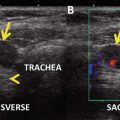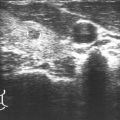Fig. 47.1
Preoperative and month 18 FDG-PET whole-body imaging of the presented patient. Areas highlighted in red indicate observed macroscopic disease at each time point
The patient underwent total thyroidectomy and left modified radical neck dissection, partial upper sternal split, and removal of thrombus from the internal jugular to innominate veins. The tumor invaded the vasculature adjacent to the pharynx, necessitating resection of pharyngeal musculature but with preservation of mucosal integrity; gross residual disease was left after surgery (R2 resection).
Pathology revealed an 8.5 × 4.8 × 4.0 cm, 184.5 g left thyroid mass extending into perithyroidal soft tissue with perineural involvement; deep soft tissue margins positive. Seven of twenty-one lymph nodes were involved with ATC, with extranodal extension present. TNM classification was pT4bN1bM0, AJCC stage IVB.
Early postoperative locoregional complications included a chyle leak, an abscess requiring drainage, an infected sternal wound requiring debridement, and an esophageal stricture. QOL decreased to 5 postoperatively.
Intensity-modulated radiotherapy (IMRT) to the neck and upper mediastinum was administered over 6 weeks (200 cGy 5 days a week, 33 fractions, total dose = 6600 cGy). He received doxorubicin and docetaxel (each at 20 mg/m2/week for 7 weeks, pre-and concurrently administered with IMRT) followed by two cycles of 60 mg/m2 each every 3 weeks.
At 3 months post-op, his QOL = 3. PET/CT scan showed no apparent recurrence or metastases. Three months later, a PET/CT scan demonstrated a new 11 mm right lower lung lesion (max. SUV = 4.2) and an indeterminate hypermetabolic focus in the right hilum (SUV = 2.8). The right lower lung lesion was treated with stereotactic body radiotherapy (SBRT), 54 Gy in 3 fractions.
Ten months after surgery, quality of life had increased to seven. PET/CT showed increased size and intensity of a C6 spinous process lesion (max. SUV = 8.1, formerly 4.9 on imaging 5 weeks earlier); he received 3000 cGy SBRT. Thirteen months following surgery, quality of life had increased to nine, and the patient was active in carpentry work related to the construction of a new home. PET/CT, however, indicated a new right lower lung nodule proximal to the previously treated lung lesion (1.4 cm, max. SUV 5.2); this was treated with CT-directed cryoablation with good tolerance of the procedure.
Three months later, a left lower lung lesion had increased from 0.5 to 1.7 cm and SUV from 1.8 to 8.7. A new lesion in the right back (levator scapulae) musculature (SUV = 8.3) was also identified. Cryoablations of the musculoskeletal lesions were uneventful. Subsequent cryoablation of the lung lesion, however, resulted in a pneumothorax (requiring chest tube decompression), air embolization (including coronary arteries and requiring hyperbaric therapy), ventricular tachycardia (requiring cardioversion), and transient neurologic deficits (expressive aphasia and right upper extremity weakness). Nineteen months after surgery, a scalp lesion was biopsied (IHC stain was negative for ALK expression) and the following month systemic therapy (weekly docetaxel and doxorubicin) was resumed. Quality of life score decreased to 2. At most recent follow-up, 22 months after initial surgery, the QOL score had increased to 6, and the patient had resumed carpentry work on his home under construction. PET/CT showed asymptomatic and globally stable lung and levator scapulae lesions, but new suspicious levels 3 and 5 neck lymph nodes.
Literature Review
A review of 34 series from 1987 to 2009 showed that in 27, R2 or debulking resections were performed [3]. In another review of prognosis, 17 of 21 series reported that extent of surgery correlated significantly with outcomes, as patients with R0 or R0/R1 resections survived longer [2], presumably due to tumors being less aggressive and more resectable.
More recently, several authors have provided additional detailed results on extent of surgery and outcomes. Ito et al. [4] reported on 40 patients with stage IVB (n = 25) or IVC (n = 15) disease further dividing the former group into IVB-a (extension into the soft tissue, trachea, larynx, recurrent laryngeal nerve, or esophagus) or IVB-b (encasement of the carotid artery or mediastinal vessels or invasion of the prevertebral fascia). Table 47.1 depicts their results by stage and extent of surgery. Only one of the six IVB 1-year survivors had an R1 resection (still alive after 4.5 years); the other five long-term survivors had R2 resections, with median survival of 546 days (range, 386–716). All six had received external radiation, and five were given chemotherapy. The lone stage IVC long-term survivor (684 days) received only radiation therapy.
Table 47.1
Extent of surgical resection and survival in 40 patients with stages IVB and IVC anaplastic thyroid carcinoma
Surgery extent | Survival | ||||
|---|---|---|---|---|---|
Stage (no.) | R1 | R2 | None | 1 year (%) | Median (days) |
IVB-a (12) | 2 | 10 | 0 | 5 (42 %) | 287 |
IVB-b (13) | 0 | 3 | 10 | 1 (8 %) | 119 |
IVC (15) | 0 | 5 | 10 | 1 (7 %) | 125 |
Akaishi et al. [5] retrospectively reviewed 100 cases of ATC from 1993 to 2009, including stages IVA (n = 11), IVB (n = 31), and IVC (n = 58). One-year survivals for each stage were 73, 23, and 7 %, respectively; the authors noted that “survival after complete resection was significantly better than after incomplete resection or no resection.” Nine patients survived more than 1 year (Table 47.2). As expected, those with IVA disease had the longest median and overall survival; however, 8 of the 19 patients had less than complete surgical resection. All 19 had received adjuvant radio- and chemotherapy.
Table 47.2
Extent of surgery in 19 patients with anaplastic thyroid carcinoma surviving more than 1 year
Stage (no.) | Resection complete | Debulk | Survival (months) | Still alive
Stay updated, free articles. Join our Telegram channel
Full access? Get Clinical Tree
 Get Clinical Tree app for offline access
Get Clinical Tree app for offline access

|
|---|


